Generating leads is a multifaceted endeavor, necessitating a strategic approach encompassing diverse touchpoints across various channels to maximize lead acquisition.
As you construct your lead generation funnel, it’s crucial to recognize the importance of establishing multiple touchpoints directly on your website. Simply attracting visitors to your site is insufficient; the ultimate goal is to persuade them to convert into leads or even paying customers during their visit.
Utilizing case studies can be particularly effective in this regard, as they offer tangible evidence of the results your brand, product, or service can deliver to real clients. By substantiating your promises and addressing pertinent questions such as how, what, who, and why, case studies serve as compelling tools for nurturing leads and expediting revenue growth.
B2B case studies serve as powerful tools for cultivating trust and demonstrating your capability to deliver tangible results for clients, thereby instilling confidence in potential leads. When crafted effectively, case studies typically achieve the following objectives:
Benefits of Case Study for Your Brand:

- Establish Persona or Audience Segment: By delineating the persona or audience segment to which the client belongs, case studies resonate with leads who can relate to similar challenges and aspirations.
- Identify Client’s Problem: A comprehensive case study elucidates the specific problem or challenge faced by the client prior to engaging with your brand, providing context for the solutions implemented.
- Detail Solution Offered: The case study articulates the solution provided by your brand, offering insights into the strategies, products, or tactics employed to address the client’s needs effectively.
- Highlight Results: Central to a compelling case study is the presentation of results achieved post-implementation of your solutions. The inclusion of specific, numerical data showcasing improvements serves as invaluable evidence of your expertise and efficacy.
- Incorporate Client Impact Statement or Testimonial: Whenever possible, integrating a client impact statement or testimonial further enhances the credibility and persuasiveness of the case study, offering firsthand validation of your brand’s effectiveness.
Real Life Examples of Impactful Case Study by Brands:
A. AdEspresso
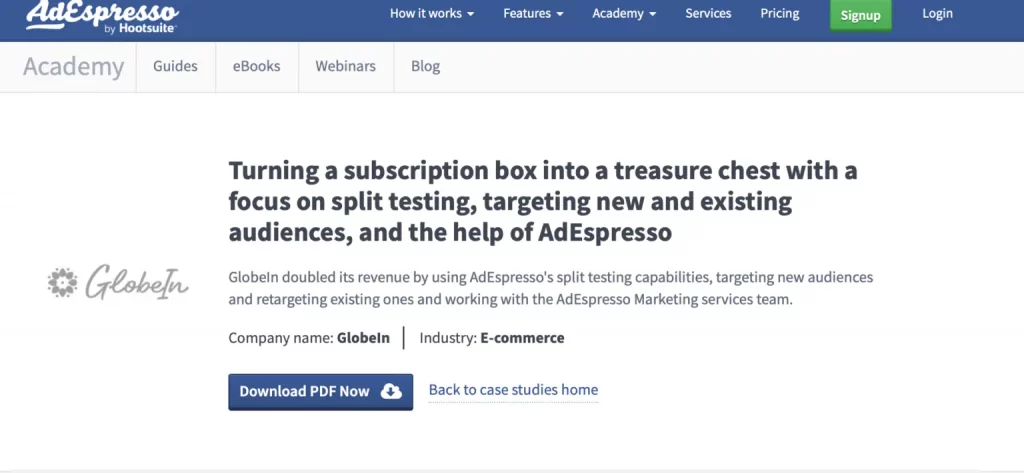
AdEspresso presents a compelling example of leveraging case studies as lead magnets, seamlessly transitioning from piquing users’ interest to converting them into leads. Let’s delve into how their approach unfolds:
- Discovery Process: Users encounter the case study through various channels such as organic search, email referrals, paid social ads, or blog posts. Upon reaching the case study section of the site, they are drawn in by the title and description.
- Title and Description: The title and description succinctly outline the company name and achievements, as well as a brief explanation of the strategies employed, including split testing, audience targeting, and the utilization of AdEspresso’s platform. A concrete result, such as “GlobeIn doubled its revenue,” immediately captures attention and establishes the potential benefits.
- Encouraging Downloads: Users are encouraged to download the PDF for deeper insights. This call-to-action prompts them to delve further into the case study’s content, signaling their interest in learning more.
- Landing Page Conversion: Clicking on the “Download PDF” CTA redirects users to a dedicated landing page featuring a lead form. Here, users are required to fill out the form to access the PDF. This strategy effectively converts interested users into leads by gating access to the valuable content.
- Strategic Insights: The PDF and accompanying landing page provide detailed insights into the strategies employed and the results achieved. By withholding some information and requiring users to download the PDF, AdEspresso encourages deeper engagement and incentivizes lead capture.
- Content-Based Approach: Unlike conventional case studies, AdEspresso’s approach emphasizes strategic insights over mere results. By offering actionable content akin to a blog post, they position their case study as a valuable educational resource. This content-centric strategy serves as a distinct touchpoint in the digital sales funnel, engaging users and providing them with practical knowledge to enhance their own campaigns.
B. Freshbooks
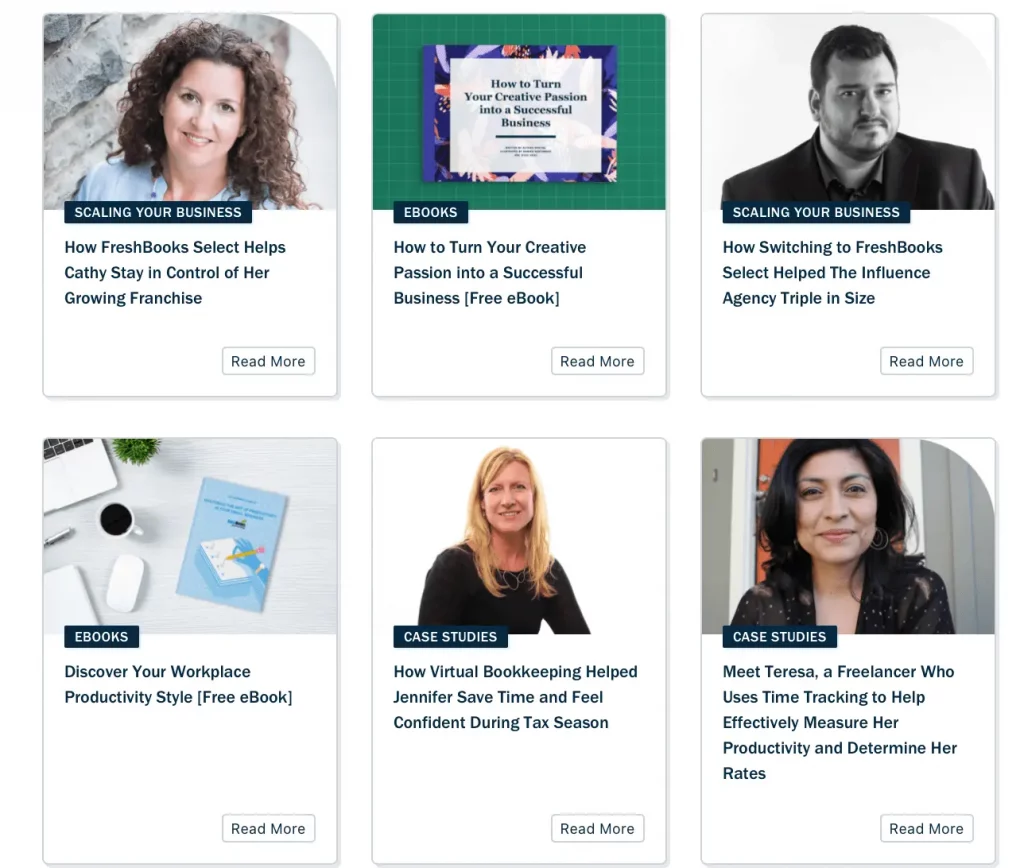
Freshbooks exemplifies adept segmentation in their case study strategy, catering to diverse buyer personas and audience segments. Let’s dissect their approach and key features:
- Segmented Content: Recognizing the multifaceted nature of its target audience, Freshbooks publishes a variety of case studies that resonate with different buyer personas and audience segments. This segmentation ensures that their content speaks directly to the unique needs and challenges of each group.
- Diverse Customer Stories: Freshbooks’ case studies feature concise yet compelling narratives from relatable small businesses, steering away from the traditional focus on mega CEOs of Fortune 500 companies. This approach resonates more strongly with their core audience, which primarily comprises small business owners and entrepreneurs.
- Representation of Various Personas: The case studies showcase a range of personas, including agencies seeking rapid scaling, growing franchises, small businesses requiring tax assistance, and freelancers leveraging time-tracking features for productivity and rate assessment. This diverse representation highlights Freshbooks’ versatility in addressing the varied requirements of different businesses.
- Targeted Appeal: By spotlighting different use cases, Freshbooks effectively communicates the specific benefits of their tool to each audience segment. Rather than presenting generic success stories, they tailor their messaging to address the unique pain points and aspirations of each persona, thereby increasing lead generation among high-value audiences.
C. Disruptive Digital
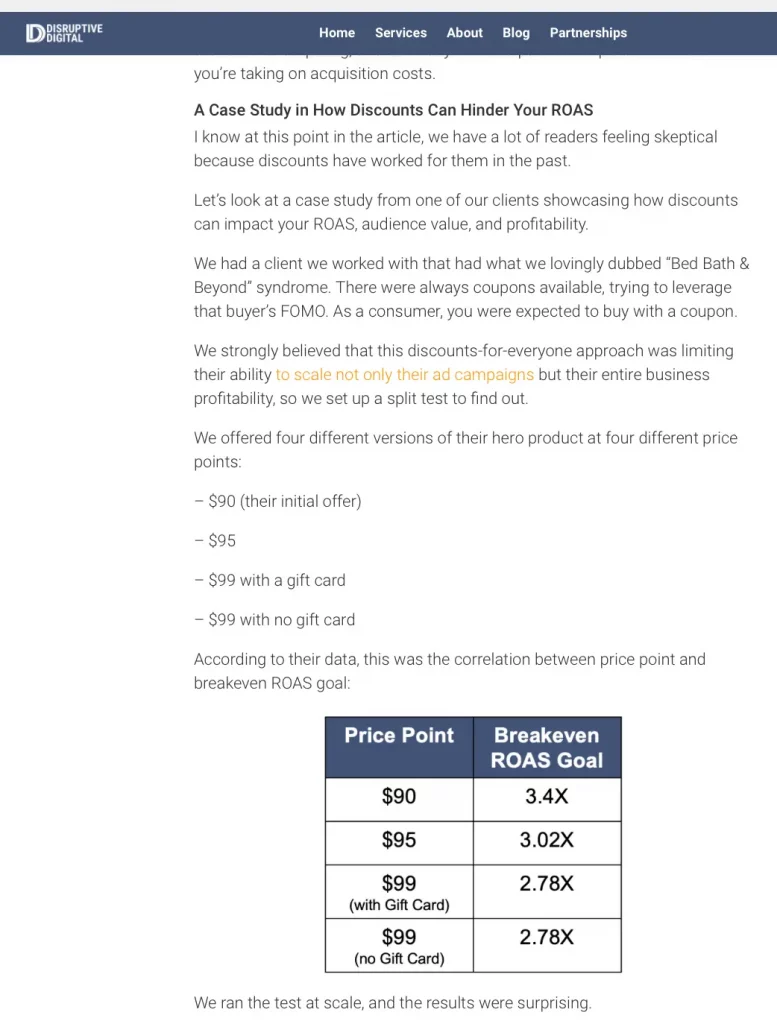
Disruptive Digital’s approach to utilizing case studies within their content strategy showcases a commitment to providing strategic insights and real-world results in the realm of paid social advertising. By incorporating case study examples into their blog posts, they elevate their content beyond generic best practices, offering tangible evidence of their expertise and the effectiveness of their methodologies. Let’s explore their approach further and identify key features.
Key Features:
- Strategic Insights Over Generic Best Practices: Disruptive Digital eschews generic industry advice in favor of offering strategic insights backed by real client data. By focusing on practical examples and tangible results, they provide valuable guidance that resonates with their audience of advertisers seeking actionable strategies.
- Integration of Case Studies into Blog Posts: Rather than relegating case studies to a separate section of their website, Disruptive Digital seamlessly integrates them into their blog posts. This approach ensures that case studies are contextualized within relevant topics, enhancing their impact and relevance.
- Illustrating Real-World Applications: Disruptive Digital enhances the effectiveness of their content by illustrating real-world applications of their strategies. By showcasing case studies with real client data, they provide concrete examples that demonstrate the effectiveness of their approach in driving results.
- Building Trust and Credibility: Incorporating case study examples into their blog posts helps Disruptive Digital build trust and establish credibility early in the customer journey. By offering transparent insights into their methods and showcasing successful outcomes, they differentiate themselves from competitors and foster trust with potential clients.
- Top-of-Funnel Appeal: While these case study examples may not reside on a dedicated landing page, they serve to attract users at the top of the funnel. By providing valuable content that educates and informs, Disruptive Digital effectively engages with potential leads early in their decision-making process.
- Content Marketing and Lead Generation: By leveraging case studies within their blog content, Disruptive Digital strengthens their content marketing efforts while simultaneously driving lead generation. Their strategic approach to content creation not only educates their audience but also serves as a powerful tool for attracting and converting leads.
D. CoSchedule
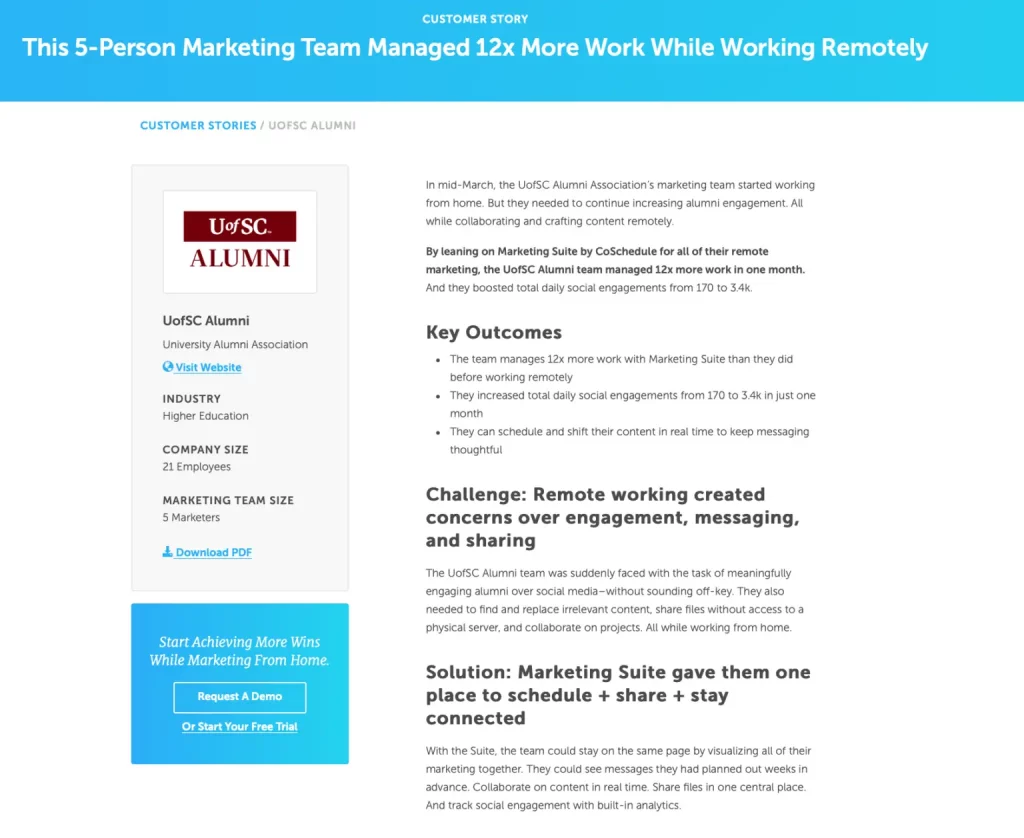
CoSchedule, renowned for its SaaS content and social media planning tool, stands out for its exceptional case studies. These case studies exemplify strategic storytelling and effective formatting to showcase the platform’s impact across diverse clientele. Let’s delve into their approach and key features.
Key Features:
- Diverse Clientele Representation: CoSchedule’s case studies feature a variety of clients, showcasing the tool’s versatility across different industries and organizational types. This inclusive approach demonstrates the platform’s adaptability and broad applicability.
- Striking Formatting: The case studies are visually appealing, with attention-grabbing headlines and quick-reference bars providing key information about the featured brand. Bold colors and design elements draw the reader’s eye, ensuring essential details stand out amidst the content.
- Convenient Download Options: CoSchedule offers the option to download the case study as a PDF, transforming it into valuable content and a lead magnet. This convenience enhances user experience and facilitates lead generation by providing users with easily accessible resources.
- Clear Call-to-Action (CTA): Each case study includes a prominent CTA, inviting readers to request a demo or get in touch. This strategic placement encourages further engagement and facilitates the conversion process, guiding interested prospects towards taking the next step.
- Comprehensive Case Study Structure: The case studies follow a structured format, typically outlining the challenge faced by the client, the solution provided by CoSchedule, and the resulting impact. This clear delineation enhances readability and allows readers to easily grasp the narrative arc of the success story.
- Visual Representation of Results: CoSchedule incorporates visual elements, such as graphs and charts, to visually depict the impact of their solutions. This visual representation adds depth to the case study, making it easier for readers to understand the tangible results achieved by the client.
- Testimonial Integration: Each case study concludes with a quote from a key team member or client, providing a human touch and reinforcing the credibility of the success story. This testimonial adds authenticity and serves as a compelling endorsement of CoSchedule’s effectiveness.
E. KlientBoost

KlientBoost, a prominent marketing agency, showcases a compelling approach to case study presentation, making it worthwhile to explore their methodology. Additionally, Omnivore.io provides a notable example of case study creation tailored for hyper-niche industries. Let’s delve into their strategies and key features.
Key Features:
KlientBoost:
- Centralized Case Study Repository: KlientBoost houses its case studies under the “Results” tab on its website, ensuring easy accessibility and visibility for visitors. This centralized repository enhances user experience and increases the likelihood of users discovering the case studies organically.
- Sorting Feature for Client Qualities: The agency offers a sorting feature allowing users to filter case studies based on specific client attributes like budget size or industry complexity. This feature reassures potential clients that KlientBoost caters to clients with diverse needs while providing tangible proof of their ability to deliver results.
- Striking Presentation: Each case study features a bold, color-contrasting header highlighting core benefits achieved, such as significant results within a specific timeframe. This visually impactful presentation immediately captures attention and communicates the value proposition effectively.
- Detailed Breakdown of Strategies: KlientBoost meticulously breaks down the advanced advertising features utilized in each case study, offering transparency and insight into their methodologies. This detailed breakdown enhances credibility and empowers potential clients to understand the agency’s approach.
- Customer Testimonials and Visuals: The inclusion of customer quotes and images of ad creatives further reinforces trust and credibility. Prospective clients gain insight into the agency’s success stories and the tangible outcomes they can expect when partnering with KlientBoost.
F. ONESOURCE
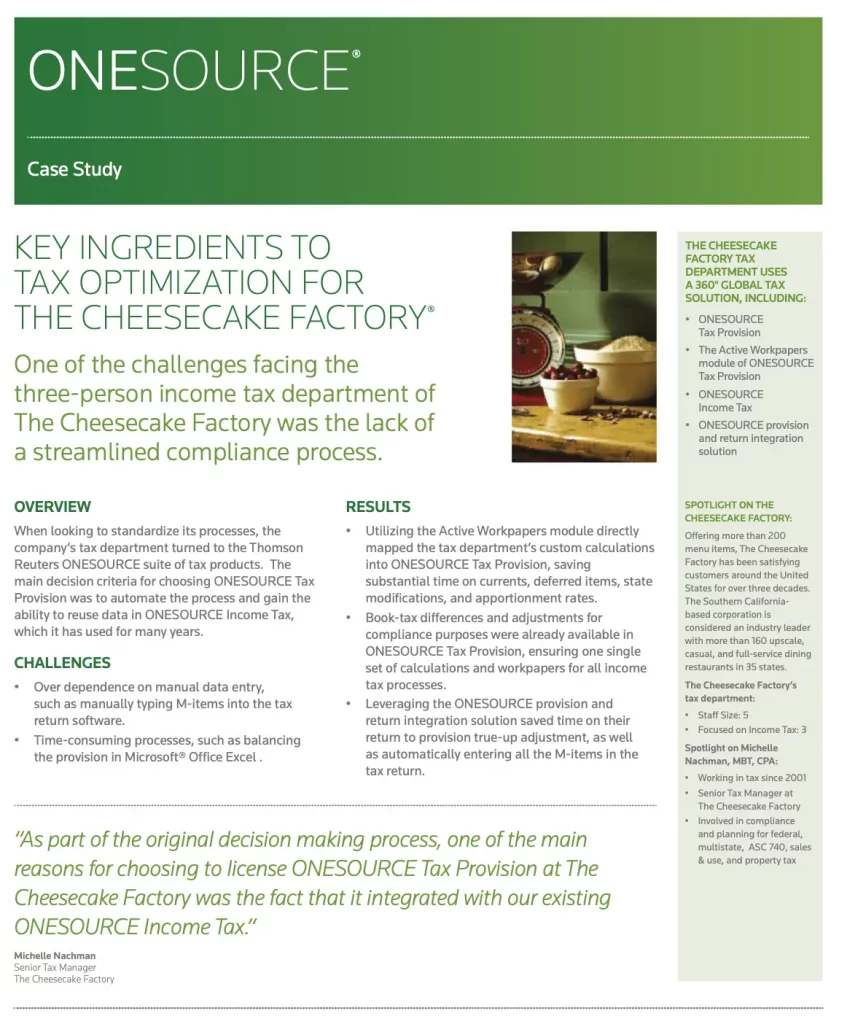
ONESOURCE is a tax preparation product from Thomson Reuters, and its website features a compelling case study of The Cheesecake Factory—a prominent American brand—to demonstrate its value proposition and drive sales.
Key Features:
- Clean and Organized Design: The case study is presented in a clean and organized format, resembling a digital brochure. Information is neatly broken down into bullet points, key quotes, statements, and subheadings.
- Focused Content: It provides only essential information, including the products used, achievements, and insights about The Cheesecake Factory’s tax department. Unnecessary details are omitted, making the content concise and effective.
G. Slack
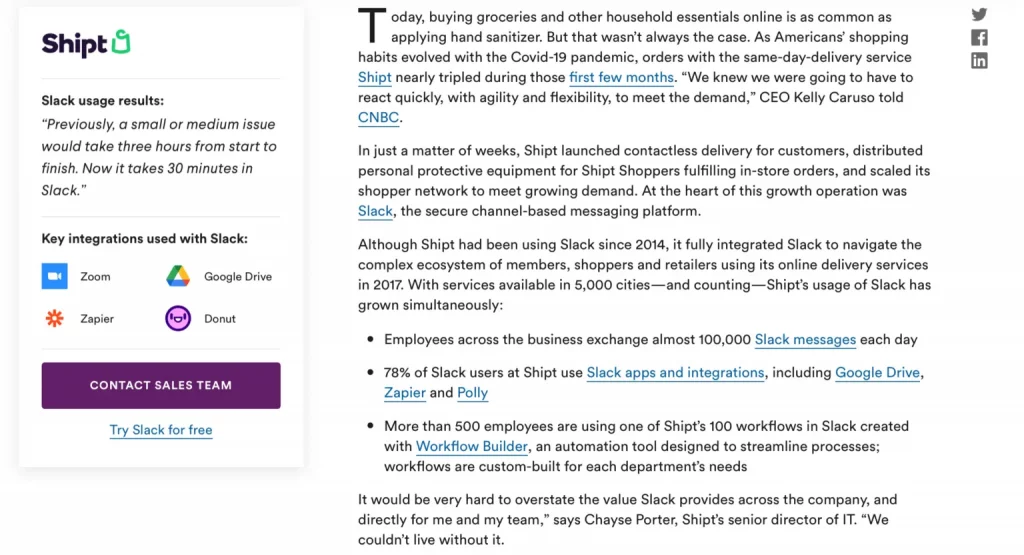
Slack, a leading instant communication chat tool, offers well-written and compelling case studies that resonate with its audience. Particularly notable is their storytelling approach, which adds depth and relatability to the content.
Key Features:
- Storytelling Approach: Slack’s case studies read like engaging blog posts, focusing on storytelling to highlight company pain points and solutions. They provide context about how businesses adapted during the COVID-19 pandemic, with a focus on specific companies like Shipt.
- Data and Statistics: They include data and statistics about product usage and effectiveness, adding credibility to their claims.
- Interactive Elements: Slack incorporates interactive elements like quick facts tabs, quotes from key figures, and CTAs for contacting the sales team or trying Slack for free.
H. Culture Amp

Culture Amp specializes in helping brands maintain and enhance their communication culture through feedback and communication response tools. Their case study examples demonstrate the effectiveness of their platform in real-world scenarios.
Key Features:
- Engaging Content: Culture Amp’s case studies are engaging to read, employing creative writing techniques to keep readers hooked. They avoid a purely technical approach, opting for a more narrative style.
- Personal Touch: They introduce key figures from the Slack department who worked directly with Culture Amp, adding a personal touch and enhancing the study’s credibility.
- Comprehensive Explanation: Despite being longer than some other case studies, Culture Amp thoroughly explains how their platform was utilized by the featured brand to achieve success.
Best Practices to Develop Case Studies:
- Consistent Template: Maintain a uniform template across your case studies to facilitate readability and familiarity for leads. A standardized format streamlines the presentation of information and enhances the navigability of your case study section on your website.
- Narrative Structure: Construct a compelling narrative that utilizes the client’s challenges and pain points to resonate with potential leads. Frame the problem as the beginning of the story, the solution as the climax, and the results section as the resolution, effectively engaging readers on an emotional and logical level.
- Balance Detail and Brevity: Strike a balance between providing sufficient detail and keeping the case study concise. While B2B case studies may inherently require more extensive content than their B2C counterparts, ensure that every piece of information adds value. Avoid overwhelming readers with unnecessary verbosity to maintain their interest and engagement.
- Incorporate Hard Facts: Integrate concrete statistics, tactical solutions, and quantifiable data throughout the case study. Hard facts lend credibility to your claims and substantiate the efficacy of your solutions. Additionally, leveraging impressive statistics in the title can enhance click-through rates and capture attention effectively.
- Optimized Formatting: Opt for clear and visually appealing formatting to enhance readability. Avoid presenting the case study as a monolithic block of text; instead, utilize headings, bullet points, and visuals to break up content and facilitate easy comprehension. Incorporating relevant visuals wherever possible adds visual interest and reinforces key points.
Conclusion:
In examining case study examples from ONESOURCE, Slack, and Culture Amp, it’s evident that compelling storytelling, focused content, and engagement strategies are key elements in creating impactful case studies. Each brand leverages its unique strengths to showcase their value proposition and drive sales effectively. By adopting a customer-centric approach and emphasizing real-world results, these case studies demonstrate the power of strategic communication and transparency in building trust and credibility with their audience.
FAQs on Case Study Examples:
How can storytelling enhance the effectiveness of case studies?
Storytelling adds depth and emotion to case studies, making them more relatable and engaging for readers. By framing the customer’s experience as a narrative, businesses can capture attention, build empathy, and highlight the transformative power of their products or services.
What role do interactive elements play in case studies?
Interactive elements like quick facts tabs, quotes from key figures, and CTAs can make case studies more dynamic and actionable. They provide additional context, encourage reader engagement, and prompt potential customers to take the next steps, such as contacting the sales team or trying out a product or service.
How can businesses ensure the authenticity and credibility of their case studies?
To ensure authenticity and credibility, businesses should strive for transparency and honesty in their case studies. Including real data, testimonials, and references adds credibility, while avoiding exaggerated claims or selective information presentation helps maintain trust with the audience.



